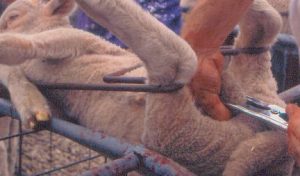FA youngstock processing
Small ruminant castration
For castration, small ruminants are essentially small calves. The same techniques apply
- surgical
- blade to open the scrotum with testicle removal by traction, emasculator, or ligature
- bloodless
- Bander/rubber bands – common method; may be inhumane in older goat kids as it causes more inflammation over a longer period of time

- Burdizzos- stagger crushes to avoid the same issues seen with banders
- Callicrate bander – for older goats
- Short scrotum method – the scrotum is banded below the testicles, leaving the testicles in place but pushed close to the body so that the body heat kills the sperm; avoid in older animals.
Goats are very sensitive to pain so it is essential to provide sedation and analgesia. Goats are also very sensitive to lidocaine. A maximum dose of 4 mg/kg is recommended. Lidocaine used for blocks can be diluted to make the small volume go further; this does result in a shorter duration of action. Hint : Lidocaine is 2% or 20 mg/ml. This sensitivity also means the LidoBands (lidocaine infused bands) also exceed the toxic dose for most young goats or lambs.
Preoperative NSAID options include flunixin meglumine iv or meloxicam orally. Sedative options include xylazine or detomidine (careful with xylazine dosing and avoid these drugs in sheep) or diazepam/ketamine or midazolam/ketamine.
From “Does local anaesthetic reduce pain in rubber ring castration of neonatal lambs?” Veterinary Evidence (2024) Vol 9 Iss 1
“In conclusion, LA [Local anesthestic] administered into the scrotal neck, spermatic cord and testes of lambs 15 minutes before castration with rubber rings may virtually eliminate pain. However, where this is not possible, injection of 0.3 ml of lignocaine 2% into the scrotal neck or each testis of a neonatal lamb at the time of castration may aid reduction of pain.”
Goats are also prone to tetanus so should receive tetanus vaccination.
Many goats are disbudded and castrated in the first week of life. Pet goats may benefit from later castration and more growth prior to castration, particularly in case it helps maximize urethral diameter and lowers the risk of obstructive urolithiasis.
How to castrate a goat
Key Takeaways
Small ruminants may be castrated by surgical or crushing techniques; banding is not ideal and is being gradually replaced by the short scrotum method in other countries.
Goats need preop analgesia and local blocks; sedatives can be helpful. Be careful with xylazine in sheep.
Small ruminants are sensitive to lidocaine; careful dosing is essential.
All small ruminants need tetanus vaccination.
Resources
Small Ruminant Castration Guide – includes other resources
The short scrotum method of castration in lambs
Caudal paramedian approach to cryptorchidectomy in 29 small ruminants (2011-2019). Veterinary Surgery. 2021;50:170–176.

